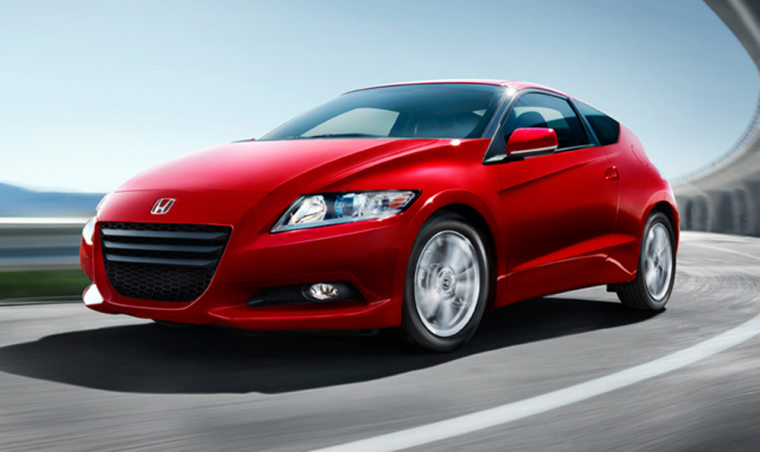“Who is Lady Gaga?” asked a neighborhood mom recently. “She’s the Madonna of 2010,” I explained. Lady Gaga trades on the fact that there remains a market for calculated outrageousness just as there was when the Material Girl burst scandalously onto the scene in 1983.
Honda hopes there is similarly enduring demand for taut, efficient little two-seat hatchbacks. The company debuted the original CRX in 1983, tapping a demand for a car that was both frugal and fun, but sent it on hiatus in 1992 for the duration of the SUV boom.
With consumers’ interest recently refocused on efficiency, Honda trotted out an updated version of its beloved old model. The company’s goal, said chief engineer Norio Tomobe, was to build a car that is “intrinsically fun to drive.” In an era of uncertainty about fuel availability, Honda has replaced conventional sports cars such as the S2000 roadster and the mid-engined Acura NSX with an unorthodox sporty hybrid that has efficiency as one of its hallmarks. Tomobe calls this approach “responsibly indulgent.”
The “responsibility” portion of this equation depends on fuel efficiency and safety. The old CRX was pretty efficient: the most efficient model scored 38 mpg city and 47 mpg highway when measured by the test the EPA has used since 2008. But at 1,890 pounds it had little protective structure and no air bags, so on today’s brutal crash tests it would probably score somewhere just ahead of Humpty Dumpty’s shell.
That car’s 1.3-liter engine only made 58 horsepower, so a more representative model is the Si sport variant, which by 1991 cranked out 108 hp and 100 lb.-ft. of torque in a car that weighed 2,174 pounds and earned 24 mpg city and 30 mpg on the EPA’s highway test when equipped with a manual transmission.
Heavier CR-Z
The CR-Z is substantially heavier, at 2,637 pounds. But all that mass, in the form of high-strength steel and air bags, protects occupants well enough to rate an expected four-star score on the government’s recently toughened crash tests.
Naturally that mass takes the edge off the CR-Z’s responsiveness, but Honda engineers have masked the surplus weight like an episode of “What Not to Wear.” Honda’s engineers have been masters of tuning four-cylinder engines for performance and character since the introduction of the groundbreaking 1969 CB750 motorcycle, and this talent shows in the CR-Z.
The sporty manual transmission-equipped model revs and rips in response to the gas pedal like any good Honda sports car of the past, but now it is invisibly fortified by an electric assist motor. This gives the CR-Z’s 1.4-liter engine a total output of 122 hp and 128 lb-ft. of torque. In contrast to most small Hondas, the CR-Z has abundant low-end torque because of the electric motor’s contribution, making the CR-Z easy to drive in stop-and-go traffic. The manually shifted CR-Z is rated at 31 mpg city and 37 mpg highway, which puts it ahead of the tinier and slower Smart fourtwo minicar.
Unfortunately, about 70 percent of buyers will never discover the CR-Z’s light, accurate six-speed shifter or the easy clutch because they will opt for the continuously variable automatic transmission. This setup dulls the CR-Z like four deflated tires, as the vague transmission combines with reduced engine power to make the CR-Z entirely mundane. But customers who seek only an exciting looking commuter with good fuel economy won’t notice, and they will appreciate the CVT’s superior 35 mpg city/39 mpg highway EPA numbers.
Drivers can influence the fuel economy and the performance by selecting the “Econ” or “Sport” modes. “You can get significantly better mileage in Econ mode,” promises Honda executive vice president of sales John Mendel. You can also cure a headache with a guillotine, but it isn’t recommended practice. Better to leave the CR-Z in the zippier Sport mode and appreciate it for its virtues.
Buck Rogers
Inside, CR-Z embraces the Buck Rogers retro futurism of a bygone era with shiny metallic door panel fabric textures that evoke the speaker grill of a 1950’s pocket transistor radio. The large round central tachometer (with an integrated digital speedometer) recalls the Batmobile’s turbine exhaust, especially at night when its red center fades to blue backlighting at the fringe.
Interior surfaces are a notch above those in other budget Honda models, with the hard plastic surfaces softened to the touch by a rubbery coating. A unique new process infuses tin into the plastic door handles lending the bargain-basement material the expensive modern appearance of nickel-plated plumbing fixtures.
The CR-Z lacks a lumbar adjuster on its seats, even as an option, but the seats are upgraded from the uncomfortable perches in the car’s mechanical siblings, the Fit and Insight. The seats’ structure is instead borrowed from the Accord, making them better suited for a few hours in the saddle. A few hours in the Fit will have the driver using the navigation system to locate the nearest chiropractor.
As enjoyable as the CR-Z is on its own merits, it is a platypus of a car. While it might seem that consumers could gloss over the question of whether it is an efficient sports car or a quick hybrid economy car and appreciate the car for what it is, history shows if drivers can’t pigeonhole a car, it is often left off shopping lists.
The CR-Z’s efficiency is good, but not spectacular. Same for performance. But the car has head-turning good looks, decent practicality thanks to its large hatch, and storage space where there is a microscopic back seat in other markets. One would hope that in an automotive market plagued by sameness that there is room for car built for fun. That strategy seems to have worked for Madonna and Lady Gaga.
